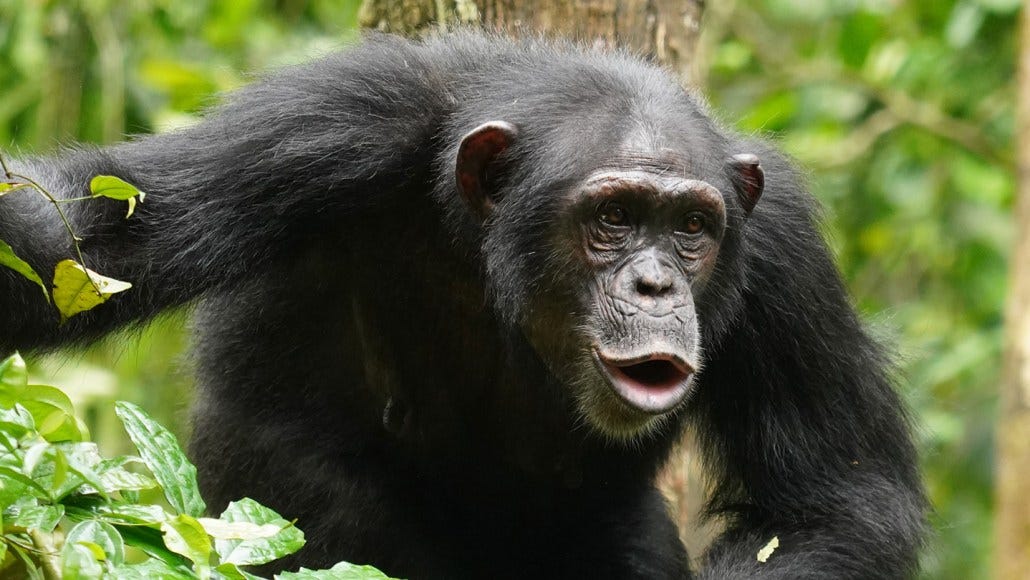In the leafy forests of Taï National Park, Ivory Coast, wild chimpanzees grunt, hoot, pant, and bark their way through complex social lives. These sounds, often dismissed as rudimentary animal calls, may in fact hint at a far more intricate system of communication than previously understood. New research1 from an international team of cognitive scientists and evolutionary anthropologists reveals that chimpanzees (“Pan troglodytes”) don’t just emit isolated signals—they combine them, and in doing so, potentially build meaning in ways that echo the earliest forms of human language.

More than noise: Combining calls to say more
Human language is structurally combinatorial. A small set of sounds, when sequenced in different ways, gives rise to an infinite variety of meanings. Animal communication, by contrast, has long been viewed as relatively fixed: one call, one message. But the new study, published in Science Advances (Girard-Buttoz et al., 2025), presents the strongest evidence yet that chimpanzees systematically use different combinations of calls to expand the range of meanings they can convey.
"Chimpanzees used each mechanism in several bigrams across a wide range of daily events. This combinatorial system allows encoding many more meanings than there are call types."
The researchers focused on 53 adult chimpanzees and recorded over 4,300 vocal utterances, including 734 instances of two-call sequences, or "bigrams." They found that these vocal pairings are not random. In fact, they often fit into one of four distinct combinatorial categories, each of which changes or enriches the meaning conveyed.
Four ways to say more with less
The team identified four mechanisms by which call pairings altered meaning:
New Meaning Creation: Some bigrams had a meaning entirely distinct from their components. For example, the combination of a "hoo" followed by a "pant" (HO_PN) was almost exclusively used during nesting—a behavior that neither individual call was used for.
Clarification or Modification: In other cases, one call served to refine the meaning of the other. The pairing PH_SC, combining a panted hoo with a scream, seemed to narrow the context in which the panted hoo was used, making its message more specific.
Meaning Addition: Some bigrams simply layered meanings together. HO_GR, for instance, carried signals associated with both feeding and resting—two contexts linked to its component calls.
Ordering Effects: Importantly, the order of calls sometimes changed the meaning entirely. A "hoo" followed by a "grunt" (HO_GR) was not used in the same situations as a "grunt" followed by a "hoo" (GR_HO), highlighting a sensitivity to syntax-like structure.
"Ordering effects can apply to both noncompositional and compositional bigrams. Changing the order of two calls shifted the event distribution and the presumed meaning."
This means that, much like in human language where "dog bites man" differs sharply from "man bites dog," chimpanzees seem to care about sequence.
Communication beyond alarms
Most prior studies documenting combinatorial signaling in animals focused on alarm calls: specific, evolutionarily urgent situations like predator encounters. This study, however, demonstrates that chimpanzees deploy these mechanisms across a range of everyday behaviors—feeding, grooming, resting, social merging, even nesting. This breadth suggests their vocal system is not narrowly tuned to emergencies but is an open toolkit for social navigation.
"Such a system offers considerable potential for meaning generation via the use of call combinations in a nonhuman animal."
Towards a more flexible form of meaning-making
The implications of this research stretch beyond primate behavior. It provides evidence that some of the foundational cognitive tools for language—like combining units into structured expressions and modifying meaning through sequence—were present long before Homo sapiens began to talk. The chimpanzees’ call combinations reveal a bridge between animal communication and the flexible, compositional power of human language.
A few sounds, many messages
Chimpanzees have a repertoire of about 12 common vocal units. But by using different combinations, orders, and contexts, they generate far more meanings. In linguistic terms, they are doing more with less. This finding supports predictions made by evolutionary models of language, like those of Nowak et al., which propose that systems combining calls across varied social contexts and using multiple strategies for altering meaning mark a transitional stage in the evolution of open-ended communication.
Future directions
The researchers now aim to explore whether these call pairings show even more complex structure—perhaps forming three- or four-call utterances with hierarchical rules. There's also interest in how receivers interpret these sequences: Are chimpanzees simply emitting combinations, or do their companions understand the nuanced messages embedded within?
This is no longer a question of whether chimpanzees have language, but how far along the continuum of linguistic complexity their communication systems reach. As Girard-Buttoz and colleagues conclude, chimpanzee call combinations reflect a rich, flexible, and sophisticated strategy for meaning-making—one that may bring us closer to the roots of language itself.
Related research:
Townsend, S. W., & Zuberbühler, K. (2021). Compositionality in the calls of nonhuman animals. Nature Reviews Neuroscience, 22(6), 401–417. https://doi.org/10.1038/s41583-021-00474-2
Slocombe, K. E., & Zuberbühler, K. (2007). Chimpanzees modify recruitment screams as a function of audience composition. Proceedings of the National Academy of Sciences, 104(45), 17228–17233. https://doi.org/10.1073/pnas.0706741104
Nowak, M. A., Plotkin, J. B., & Krakauer, D. C. (1999). The evolutionary language game. Journal of Theoretical Biology, 200(2), 147–162. https://doi.org/10.1006/jtbi.1999.0991
Girard-Buttoz, C., Neumann, C., Bortolato, T., Zaccarella, E., Friederici, A. D., Wittig, R. M., & Crockford, C. (2025). Versatile use of chimpanzee call combinations promotes meaning expansion. Science Advances, 11(19). https://doi.org/10.1126/sciadv.adq2879









